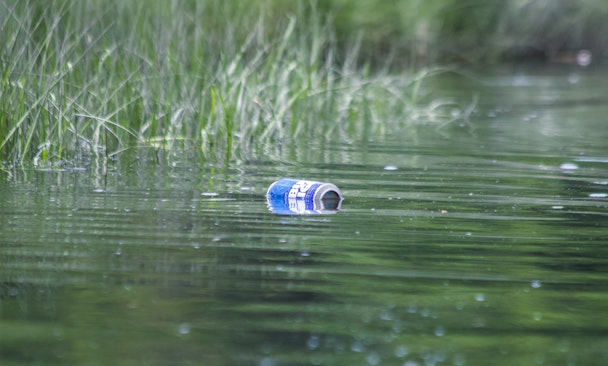After the year’s biggest PR storm, here’s what brands can learn from Bud Light
Chances are, your brand hasn’t had as difficult a year as Bud Light. After finding itself at the center of a pointed culture war, here’s what Bulletproof’s strategy chief thinks the brand’s peers can learn.

Bud Light's been caught in the rapids. Here, Bulletproof looks at how it can calm the waters / Brian Yurasits via Unsplash
One of the year’s most surprising developments has been seeing a beer (one described in a user review as “mildly flavored water with a few bubbles”) thrown into the center of culture wars and political turmoil.
Yes, this is a Bud Light piece.
Around any major piece of PR, the question always comes up: “What’s going to be the damage/benefit to my brand?” Well, how long’s a piece of string?
Having had my fair share of ‘brand health at death’s door’ briefs over the years (not my fault, I assure you), I feel vaguely qualified to delve into this subject. Let’s figure out the extent of the problem and what Bud Light should do next.
WWED: what would Einstein do?
“If I had an hour to solve a problem I'd spend 55 minutes thinking about the problem and five minutes thinking about solutions”. So goes the famously misattributed ‘Einstein quote’. Apocryphal yes, but the intention is right: we need to first understand the severity of the issue, before we get to solutions.
A lot has been written about the damage to Bud Light, with estimations of sales dropping by c.25% over certain weeks, and claims that it has lost its top spot in the US beer market to Modelo.
It’s worth thinking about the context the brand found itself in before the storm. VP of marketing Alissa Heinerscheid recently explained her mandate when joining the brand: “This brand is in decline. It’s been in decline for a really long time. And if we do not attract young drinkers to come and drink this brand, there will be no future for Bud Light.”
It’s true; Bud Light’s market share had gone from around 18 to 12% over the last decade. Although it was the market leader, its category position was in turmoil. But how was that translating to a proxy for future growth: brand consideration?
Advertisement
Brand consideration: lovers and haters
According to YouGov data, Brand consideration among Americans who are Bud Light regulars was close to flat over the last year, but began to decline (around 6%) at the start of 2023, aligned to sliding market share.
Surprisingly, there’s nothing in brand consideration to give the impression that Bud Light was mid-scandal; consideration rose in points over the last couple of months. It seems that there remains a loyal core.
The data for people who didn’t buy Bud Light anyway is only marginally worse. Given it’s the market leader (still) in America, there aren’t a lot of haters; the change since the start of the year is, in real terms, only about a 13% decline (from 1.33 to 1.13).
But “people who didn’t buy Bud Light anyway will consider Bud Light a tiny bit less” won’t sell too many newspapers or stoke the fires of a boycott. For any brand, there are ‘loyals’ and there will be people who simply dislike it. But most users are the moving masses: those who flit about the category, whose patronage rests on a whim. Remember: according to Byron Sharp’s How Brands Grow, c.50% of Coca-Cola customers buy just one or two cans a year.
Advertisement
The moving masses
Looking at Bud Light brand consideration for total US beer drinkers, overall, should elicit a ‘holy shit’. From a YouGov consideration figure of 25% at the start of the year to, now, around 15%: a decline of around 40%.
Brand consideration has nearly halved in a couple of months.
The brand is suffering the consequences with buyers who may not necessarily share the views of the boycotters but who most definitely overhear the vitriol, and are being put off.
Suggested newsletters for you
How brands grow (back)
The people who pick up a couple of cans every now and again are the ones who decide brand growth because they (not your loyalists or haters) represent the majority. Therein lies the importance of branding: having a concrete answer to what you stand for that extends beyond your loyalists and doesn’t consider your haters.
So the next time you’re thinking of unintentionally inserting your brand into a political fracturing without a strategy to dictate your response: don’t do it.
…Or at least, if you’re going to do it, do it with a plan. Don’t try to placate; don’t try and ‘mehhh’ your way out. Don’t spare a thought about the haters or boycotters, they were nothing to your brand anyway; batten down those hatches, weather the storm, hide the fine china and communicate at scale to those moving masses. Hold your ground and tackle the big problem, like the monumental market share decline you’ve had over the last decade. You were heading for a brand catastrophe eventually, but one just found you.
Content by The Drum Network member:

Bulletproof
Bulletproof is a brand agency with studios in London, New York, Singapore, Amsterdam, Sydney, Shanghai and Melbourne. Proudly independent, we exist to vanquish mediocrity...
Find out more
